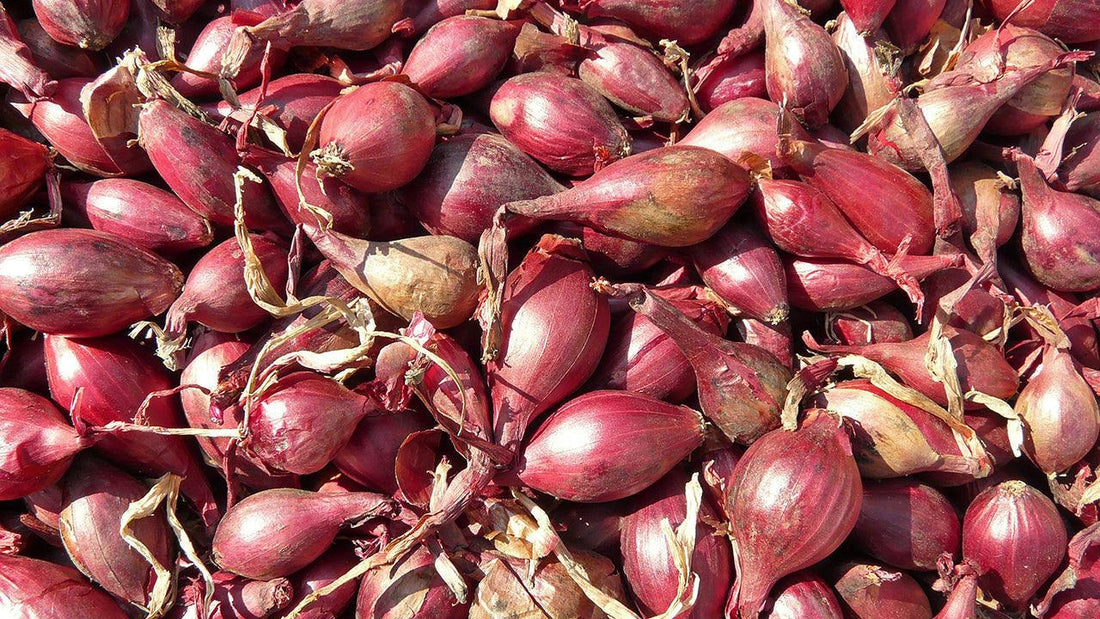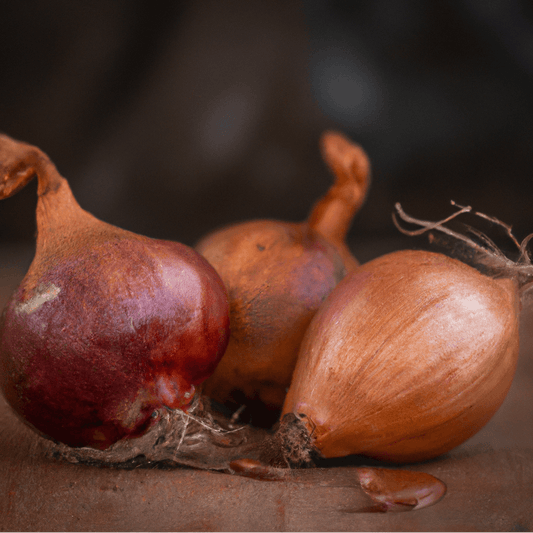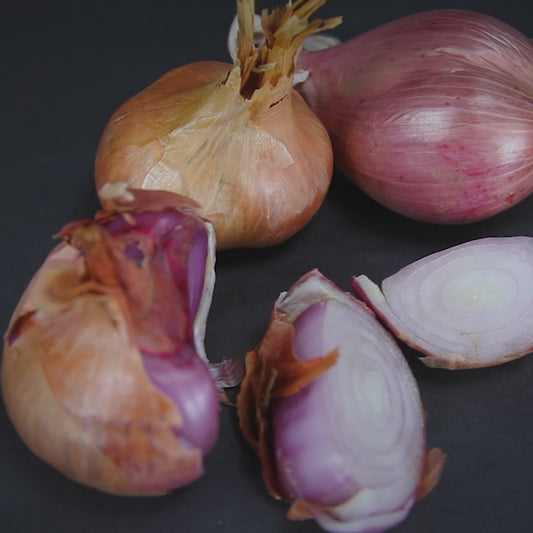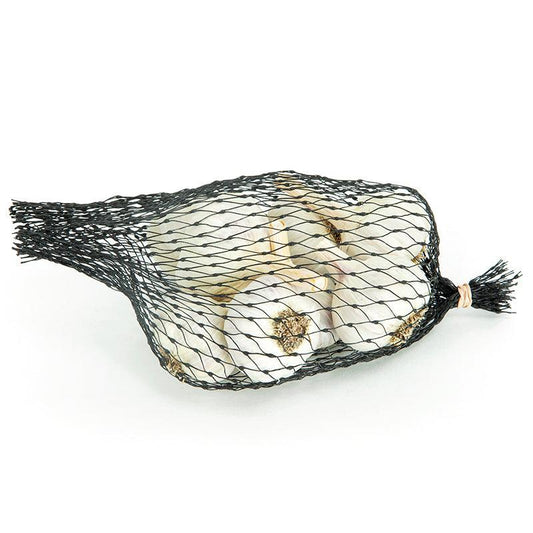How to Grow Shallots
Shallots, with their delicate flavor and versatility, are a prized addition to any kitchen garden. Growing shallots is surprisingly straightforward and rewarding, making them an excellent crop for both beginner and experienced gardeners alike. If you're familiar with green onions and spring onions, you’ll find that shallots offer a similar yet distinct flavor.
This guide will walk you through every step of how to grow shallots, from soil preparation to harvesting and storage. We'll also touch on different types of onions, highlighting the unique qualities of shallots compared to other onions like green onions and spring onions, ensuring you grow a bountiful harvest of this flavorful allium (Allium cepa).
Why Grow Shallots?
Shallots are a favorite among gardeners due to their unique flavor profile, combining the sweetness of yellow onion with the mild sharpness of garlic. They are not only easy to grow but also store well, making them a practical crop for year-round use. With the right care and attention, your garden can yield plump, flavorful shallots perfect for cooking, pickling, or even replanting. Their shallots taste makes them a preferred ingredient in gourmet recipes and an excellent option for a flavorful side dish.
Types of Shallots
There are several varieties of shallots, each with its own unique characteristics. French Red Shallots are known for their rich, sweet flavor and reddish-brown skin, making them a favorite in fine cooking. Grey Shallots, sometimes referred to as "true shallots," have a more intense and complex flavor with a greyish skin and a firmer texture. These varieties, along with other types, offer different culinary applications and growing experiences, allowing gardeners to choose the best fit for their needs.
Planting Shallots: Timing and Spacing
Shallots are typically planted from bulbs rather than seeds or cloves. This method is not only efficient but also ensures consistency in growth and flavor. For larger bulbs at harvest, choose smaller bulbs for planting—they tend to produce more substantial clusters.
When to Plant
-
In very cold climates, plant shallots in early spring to avoid frost damage.
-
In milder regions, shallots can be planted in late fall for overwintering.
How to Plant
-
Separate multiple bulbs and plant each individual bulb with the root end facing down.
-
Space bulbs 6–8 inches apart in rows spaced 10–12 inches apart.
-
Plant bulbs just deep enough so that the tip is level with the soil surface.
Unlike garlic, which forms a single bulb from a clove, shallots develop clusters of 5–12 bulbs around the original planting bulb. This spreading habit means shallots require more space between plants than garlic.
Important Note: Avoid using mulch for shallots, as it can trap excess moisture and cause the bulbs to rot. Instead, maintain a weed-free bed through regular hand weeding or hoeing.
How to Grow Shallots: Care and Maintenance
Shallots thrive when provided with consistent care. They love water and nutrients but require excellent drainage to prevent bulb rot.
Watering
-
Water deeply immediately after planting.
-
Afterward, only water when the soil is dry. Shallots need about 1 inch of water per week to grow well.
Fertilizing
-
Feed your shallots with composted manure or a balanced fertilizer in the spring before the bulbs begin to enlarge.
-
Avoid over-fertilizing, as excessive nitrogen can lead to leafy growth at the expense of bulb development.
Weeding
-
Keep the shallot bed free of weeds, as competition for nutrients and water can hinder growth.
-
Hand-pull weeds carefully to avoid disturbing the bulbs.
Bolting
-
If seed stalks form (a process called bolting), remove them promptly. Bolting diverts the plant’s energy from bulb development to seed production, which can reduce the size and quality of your shallots.
Harvesting Shallots: Timing is Everything
Shallots are ready to harvest when their leaves turn brown and begin to fall over. This typically occurs in mid to late summer, depending on when you planted them.
-
Use a garden fork or trowel to loosen the soil around the bulbs.
-
Gently dig up the clusters, being careful not to damage the bulbs.
-
Shake off excess soil and lay the shallots out to cure in a well-ventilated, shady location for about one month. Proper curing helps to extend their storage life and enhances their flavor.
Storing Shallots for Long-Term Use
Once cured, trim the dried tops and store the shallots in a cool, dry place (around 50°F). Mesh bags work well for storage, allowing proper air circulation to prevent moisture buildup. Keep shallots away from apples and tomatoes, as these fruits emit ethylene gas that can cause shallots to spoil prematurely.
-
Smaller bulbs can be saved for replanting in the next growing season, ensuring a sustainable cycle of growth and harvest.
How to Grow Shallots: Overcoming Common Challenges
Even though shallots are relatively low-maintenance, some issues may arise:
-
Pests: Watch out for gophers and onion maggots. Protect your beds and inspect plants regularly.
-
Rot: Poor drainage or overwatering can lead to bulb rot. Ensure your soil is well-drained and avoid planting in low-lying areas.
-
Weeds: Weeds compete with shallots for nutrients. Regular weeding is essential for optimal growth.
Why You Should Grow Shallots in Your Garden
Shallots are a rewarding crop for any gardener. They are easy to grow, store well, and add exceptional flavor to a variety of dishes. With their white flesh and teardrop-shaped bulbs, shallots are both visually appealing and practical. As a member of the allium family, they can often be used in place of green onions, spring onions, or even red onions, offering versatility in countless recipes. Compared to other types of onions, shallots have a milder, sweeter flavor that makes them a favorite among chefs and home cooks alike.
If you're interested in growing shallots, this guide will show you exactly how to grow shallots—from choosing the right location and soil to proper shallot planting techniques. Whether you're a seasoned gardener or just starting out, shallots are an excellent addition to your garden. And if you're ready to get started, look for high-quality shallot seeds for sale to ensure a healthy and productive crop. With the right care, you’ll enjoy fresh, homegrown shallots year after year while saving money and elevating your cooking.
Check out our Garlic Resource Center for even more information about garlic and the varieties we offer. Or, use our Garlic Selector Tool for a customized garlic list matched to your climate, gardening style, and flavor preferences.
FAQ: How to Grow Shallots: Your Complete Guide to Growing Shallots and Proper Shallot Planting Techniques
-
What is Allium cepa?
- Allium cepa is the scientific name for the species that includes shallots, onions, and garlic. Shallots are a type of Allium cepa, prized for their delicate, mild flavor and versatility in cooking.
-
How do shallots taste compared to other onions?
- Shallots taste like a mild blend of yellow onion and garlic, offering a unique, sweet flavor with a slight sharpness. This makes them a preferred choice in many gourmet dishes and side dishes.
-
Can I substitute shallots for red onion in recipes?
- Yes, you can substitute shallots for red onion in most recipes. While shallots taste milder and sweeter, they can provide a more delicate flavor that complements salads, dressings, and other dishes where red onion is typically used.
-
What is the ideal shape of shallots when harvested?
- Shallots grow into teardrop-shaped bulbs, which have a beautiful, tapered appearance and are perfect for harvesting when fully mature.
-
How do you store shallots?
- After curing your shallots in a shady, well-ventilated area, store them in a cool, dry place (around 50°F). This helps preserve their white flesh and ensures they last for months without spoiling.
-
What’s the best way to plant shallots?
- Plant shallots from bulbs, spacing them 6–8 inches apart, with the root end facing down. Be sure to plant them just deep enough for the tip to remain level with the soil surface.
-
Can shallots be used in side dishes?
- Yes! Shallots are an excellent addition to side dishes, providing a mild, savory flavor that pairs well with a wide variety of foods, including vegetables, potatoes, and meats.
-
Are there different types of shallots to choose from?
- Yes, there are various types of shallots, including French Red Shallots and Grey Shallots, each offering distinct flavors and textures. These varieties can be selected depending on your culinary needs and taste preferences.






1 comment
Great information. The information helped clear my doubts about tiny shallots. Thanks a lot.